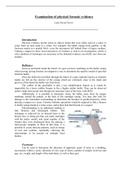Examination of physical forensic evidence
Luke David Farrar
Introduction
Physical evidence mostly refers to objects found that were either used in a crime or
come from an item used in a crime. For example; the bullet casing from gunfire, or the
footwear marks in a muddy field—even the documents left behind from a forgery incident.
Linking a suspect to these recovered pieces of evidence is vital to an investigation, which is
why a plethora of techniques are necessary as the obtained evidence can wildly vary from one
another.
Ballistics
Grooves and lands inside the barrel of a gun can leave markings on the bullet casing
when leaving, giving forensic investigators a way to determine the specific model of gun that
fired the bullet.
Once the bullet has travelled through the barrel of a gun, imprints known as striation
marks are left on the exterior of the casing which are extremely close to the lands and
grooves of the barrel the bullet was fired from.
The calibre of the gun/bullet is also a key identification feature as it would be
impossible for a lower calibre firearm to fire a higher calibre bullet. They can be observed
under a light microscope and, though not necessary most of the time, with SEM.
Additionally, it is possible to determine where the bullet came from by unique
markings around the primer, at the base of the cartridge casing. You may also look for
damage to the immediate surroundings to determine the location of gunfire/trajectory when
placing a suspect at a scene. Forensic ballistic specialists would be required to link a firearm
to bullet casing found at a crime scene, and to then link that firearm to a suspect.
Microstamping is an additional method to
link firearms and discharged bullets. This
technique is achieved by an internal laser in the
breech face or firing pin that can mark cartridges
with the make, model, and serial number of the
firearm they were discharged from. By placing a
microscopic template in front of this laser, it is
possible to create intricate patterns, such as strings
of text and symbols, repeatedly, allowing the
microstamps to be present on multiple fired
bullets.
Footwear
Can be used to determine the direction of approach, point of entry in a building,
movements within a scene, direction of exit, type of shoes, number of people involved, and
age, sex, weight, and height of the individual, as well as their gait.
, The main goal of footwear analysis is to prove that a suspect was present at the crime
scene. This can either be done after an arrest has been made or before, depending on whether
there was one or more suspects apprehended at/around the crime scene.
Two-dimensional marks
Gel lifts
For two-dimensional marks—those that are formed flat on a surface, such as dirt
trodden into a house—can be lifted with a gel lift. The gel lift itself is a sheet with one sticky
side that is covered until the cover over it has been removed. By placing the gel lift on a
smooth surface and ensuring there is no wrinkles, an impression of the dirt and other
particulates deposited by a footwear mark can be collected as they adhere to the sticky side of
the gel lift. A good technique for quick collection, though high visibility of the print is
required for effective use as collection is difficult if the location of the footwear mark is not
apparent, unlike the below technique.
ESLA
An ESLA is a portable device used to transfer impressions using an electrostatic
charge to lift the print onto metallic foil. Using foil, and a conductive metal, the ESLA can be
placed in between the two to conduct a high voltage throughout the foil, causing the dirt
particles on the floor to adhere to the foil (lifting sheet). After the electrostatic charge running
through the foil has attracted the dirt, the foil can be turned over and an impression of the dirt
will give an impression of footprints left from the dirt on shoes.
Inkless/impression printing
This technique utilises a chemically treated pad that can record the impressions of the
sole of shoes without damaging them. If a suspect is apprehended at a scene or taken in for
questioning a two-dimensional print can be taken with an even impression of the sole which
is formed shortly after the impression is complete. Since the sensitised paper in the
inkless/impression prints are designed to ensure that the entire sole is accurately recorded.
This impression can be used to compare to ones recovered at a scene. Because of the foam in
the inkless printing kit, a full representation of the markings on the shoe can be collected as
the paper is fully surrounding the paper due to the depth of the foam, which gives a print that
can be compared to both two-dimensional and three-dimensional prints equally as well.
Three-dimensional marks
Dent stone cast
These are marks that have left a visible impression—such as footprints in snow or dirt
—which can be effectively picked up using a cast. Dent stone is one such cast, what is
essentially a putty-like mixture of water and dent stone (a fine, rocky powder), that can be
moulded into an impression and then hardened over time to create a three-dimensional replica
of the footwear mark. When collecting three-dimensional evidence using a dent stone cast,
hairspray, or some other hardening agent, may be used to ensure that any marks in external
conditions—snow, mud, sand—are retrieved without the print losing its structure. Most
forensic kits include a premade mixture of dent stone and water in the correct ratio that is
simple to use but it is also possible to mix yourself on site.
Toolmarks
When analysing damage done using weapons/tools,
the impact location of the tool—the impression—is a telling
indicator as to its identity. For example, when looking at a
puncture wound on a dead body you may look for serrated




